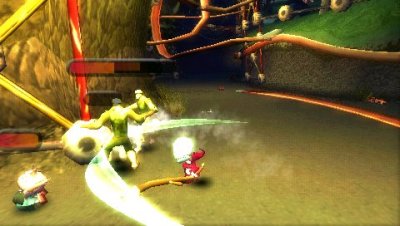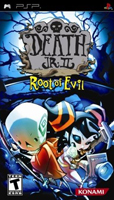BUY IT AT AMAZON:: CLICK HERE
PLATFORM: PSP
ESRB RATING: T
PUBLISHER: Konami
DEVELOPER: Backbone Entertainment
The
market holds a special place for those mediocre titles produced around a new
system’s launch. Many of these titles sell well because they’re the only apps
available. Since the PSP’s launch, Sony has trumpeted the success of their Untold
Legends franchise, because it sold well above estimates. The trouble is
that such sales do not equate to consumer faith in a particular intellectual
property.
Case in
point: Death Jr, which sold reasonably well in its first iteration on
the PSP. Somehow, the studio decided that those sales represented gamer demand
for a sequel.
(As a
side note, this kind of franchise foundation, in any medium, reminds me of that
carnival game with the water guns and the balloons; executives piss product
into a clown’s mouth until eventually the balloon pops. And then they declare
themselves the winner? I dunno. My analogy broke.)
The Pitch
Quick
question: you’ve got a game featuring Death’s boney little son and his
schoolmates. What audience would you guess for its target? I would have put it
around the level of the little darlings who watch The Grim Adventures of Billy and
Mandy; not exactly adolescent, yet, but possessing enough of a brain to
get excited by morbidity. I was wrong. It’s my own fault for not trusting the
ESRB.
Death Jr 2 – Root of
Evil is aimed
squarely at teens in their Evanescence phase, Hot Topic vagrants and the like. Its
writing is PG-13 with innuendo and mild (read: boring) cursing. The disconnect
between setting and story set up a fine wall between the gamer and the game
right off the bat. Sure, more adult stories can be told using child
protagonists, but that requires good writing, as you’d find in Psychonauts,
instead of the not-quite-ready-for-Adult-Swim stuff that clogs up the script
here.

Plus, the
whole thing is obviously a thinly-veiled bit of propaganda from the
right-wingers who didn’t enjoy An Inconvenient Truth. I mean: the
whole point of the game is run around willy-nilly destroying plant life! So
very political. Woodrue would like to have some words with the developers…
The Play
Leaving
the story baggage and unfounded criticism thereof at the train station, what
you get is a run-of-the-mill platformer. Each level has a linear progression
from one end to the other, though the layouts are well-layered and creative,
even at their worst. The requisite jumping tricks, minibosses, and minor-league
puzzles extend the lengths of these levels beyond what their size suggests.
Not that
they’re small to begin with. These levels aren’t exactly designed for a handheld
in the "pick up and play" sense. You can save anywhere, which kind of
obviates the need for easily accomplished goals, but it’s not hard to forget
exactly what you’ve done in a given level if, say, you play on the way to work
and then pick the game up again on the way home. Depending on your point of
view, this either counts in Death Jr 2‘s favor or against it.
To
further pad out the levels, there are a couple of item types to collect.
Everything you kill, or maim, or mutilate will gift you with some golden balls
of energy. You’ll also find them just lying around the levels. This energy may
be spent to upgrade your character’s moves, expanding their repertoire of
fighting and acrobatic abilities as the game progresses. You can also scour the
levels (though you don’t have to scour very hard) for different odds and ends
that can be combined to form new weapons, such as the flaming TP launcher.
The big
problem with the gameplay comes from the missing sense of cohesion. The story isn’t enough to tie the
levels together in any meaningful way, and you’ll find yourself jumping from
level to level with no real sense of progression or accomplishment. The
divisions between levels are too abstract.

The
difficulty levels also detract from the player’s immersion in the game world,
thanks to far-too forgiving frequency of health power-ups and bosses that never
live up to the challenge that their surrounding level designs seem to suggest
was intended. (Why bother making my way to a higher level and take cover when I
can beat the boss by standing in one place and shooting straight up?)
Big kudos
on the targeting system, however; it’s a little twitchy, but it’s not hard to
get used to, which subtracts most, if not all, frustration in navigating the
levels.
The Presentation
The good
folks at Backbone Entertainment have taken a page from Daxter‘s design document
in load times and areas. I mentioned that the levels are abnormally large for a
handheld; they’re not as large as those in Daxter, but they are of a size where
you’d expect some artificial barriers here and there to facilitate loading.
Fortunately, when you reach those barriers, the loading streams right across,
and you don’t actually have to put a pause in your play time. There are still about
ten seconds of loading in between levels, and when cinematics are being
prepared.
The
graphics are colorful and plenty vivid enough for Sony’s little beast. The
palette is expansive, and made good use of by the art direction. A Toontown
sense of style pervades the architecture, with enough variety in content that
it remains fun to navigate and to look at.
The
animations are even better, especially for Death and Pandora, the two playable
characters. Expressive and well-timed, the figures have quite a range of movement.
Even the enemies get a lot more to do than the relatively static walking and
shooting. Some pieces of terrain also have animated loops, which makes the
levels seems very much alive.

The Replay
There’s
only one reason to replay Death Jr 2, and that’s for the
second playable character. You can run through the action as the titular
bonehead, or as his babygoth counterpart Pandora. While each make use of the
similar weapon set (with enough variation to give them different items to hunt for) they do have separate combat
moves that can be unlocked with power. However, the game isn’t substantially
different with one character or the other, so mostly you’re in it up until
there’s nothing new to see.
The Verdict
Death Jr 2 arrives in a very different
context for the PSP than did its predecessor. There is now no shortage of
quality titles for the discerning gamer, though at present the platforming
genre remains a little underserved. Though it’s confused about its audience,
and doesn’t play well to any of them, Death Jr 2 does try hard to please
and manages (barely) to avoid being ingratiating. Its good qualities form a
tidy little list, but they fail to weigh in at more than a gamer’s
understandable ambivalence.
6 out of 10
